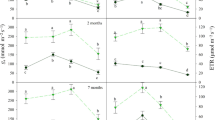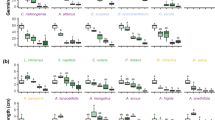Summary
Cirsium vulgare is a plant species of disturbed sites. To understand this distribution the effect of micro-organisms on the germination in this species was investigated as the microflora of disturbed and non-disturbed sites shows differences. It was found that micro-organisms from fruitcoat and environment do influence germination. In an environment containing humus, germination is stimulated.
Mortality of seedlings is higher in undisturbed sites, resulting in the observed distribution. It is hypothesized that this mortality is the result of germination, forced by microbial activity (break-down of the fruitcoat, exudation of growth-regulating substances) under conditions in which the survival chances of the seedling are low.
Similar content being viewed by others
References
Abdulla MH (1970) Preliminary study on the influence of fungal metabolites on germination of barley grains. Mycopath Mycol appl 41:307–313
Andel J van, Vera F (1977) Reproductive allocation in Senecio vulgaris and Chamaenerion angustifolium in relation to mineral nutrition. J Ecol 65:747–758
Bazzaz FA (1979) The physiological ecology of plant succession. Ann Rev Ecol Syst 10:351–371
George JM, Hutchinson MJ, Mottershead BE: Spearthistle (Cirsium vulgare) invasion of grazed pastures. Prox XI Int Grassland Congr 685–688
Gowley CO, Nickerson NC (1979) Pithiascus intermedius from seeds of Vaccinium angustifolium. Can J Bot 57:1218–1219
Grime JP (1979) Plant strategies and vegetation processes. John Wiley and Sons, New York
Harper JL, Williams JT, Sagar GR (1965) The behaviour of seeds in soil. I. The heterogeneity of soil surfaces and its role in determining the establishment of plants from seed. J Ecol 53:273–286
Harvey AE, Larsen AE, Jurgensen MF (1976) Distribution of ectomycorrhizae in a mature Douglas-fir/larch forest soil in Western Montana Forest Sci 2:393–398
Hegarty TW, Ross HA (1979) Use of growth regulators to remove the differential sensitivity to moisture stress of seed germination and seedling growth in red clover (Trifolium pratense L) Ann Bot 43:657–660
Kirkpatrick BC, Bazzaz FA (1979) Influence of certain fungi on seed germination and seedling survival of four colonizing annuals. J appl Ecol 16:515–528
Lucarotti CJ, Kelsey CT, Auclair AND (1978) Microfungal variations relative to post-fire changes in soil environment. Oecologia (Berl) 37:1–12
Lynch JM (1978) Microbial interaction around imbibed seeds. Ann appl Biol 89:165–167
Meijden E van der (1979) Herbivore exploitation of a fugitive plant species: local survival and extinction of the Cinnabar Moth and Ragwort in a heterogeneous environment. Oecologia (Berl) 42:307–323
Niemelä S, Sundman V (1977) Effects of clear-cutting on the composition of bacterial populations of Northern Spruce forest soil. Canad J Microbiol 23:131–138
Pugh GJF (1973) Saprophyte fungi and seeds. In: Seed Ecology (W Heydecker, ed) Butterworths, London, pp 337–345
Sheldon JC (1974) The behaviour of seeds in soil. III. The influence of seed morphology and the behaviour of seedlings on the establishment of plants from surfacelying seeds. J Ecol 62:47–66
Stoutjesdijk P (1972) Spectral transmission curves of some types of leaf canopies with a note on seed germination. Acta Bot Neert 21:185–191
Thompson K, Grime JP, Mason G (1977) Seed germination in response to diurnal fluctuations of temperature. Nature 267:147–149
Valadon LAG, Lodge E (1970) Auxins and other compounds of Cladosporium herbarum. Trans Br mycol Soc 55:9–15
Warcup JH (1975) Factors affecting symbiotic germination of orchid seed. In: Sanders FE, Mosse B, Tinker PB (eds) Endomycorrhizas. Academic Press, New York, pp 87–104
West NE, Chilcote WW (1968) Senecio sylvaticus in relation to Douglas-fir clear-cut succession. Ecology 49:1101–1107
Wicklow DT (1973) Microfungal populations in surface soils of manipulated prairie stands. Ecol 54:1302–1310
Wicklow DT, Whittingham WF (1978) Comparison of soil microfungal populations in disturbed and undisturbed forests in Northern Wisconsin. Canad J Bot 56:1702–1709
Author information
Authors and Affiliations
Additional information
Publication of the ‘Meijendel-comité’, Nieuwe Serie no. 55
Rights and permissions
About this article
Cite this article
van Leeuwen, B.H. Influence of micro-organisms on the germination of the monocarpic Cirsium vulgare in relation to disturbance. Oecologia 48, 112–115 (1981). https://doi.org/10.1007/BF00346996
Received:
Issue Date:
DOI: https://doi.org/10.1007/BF00346996




